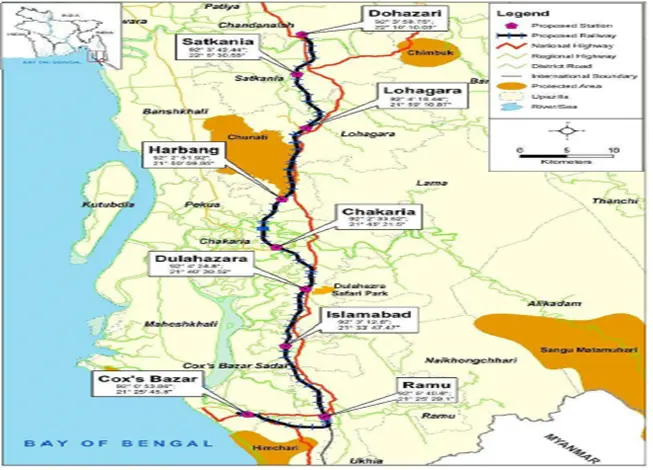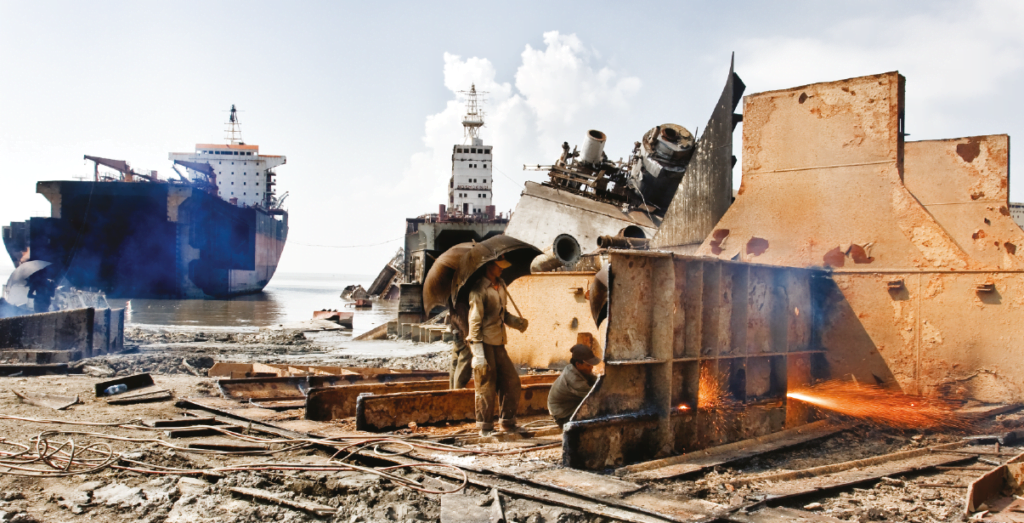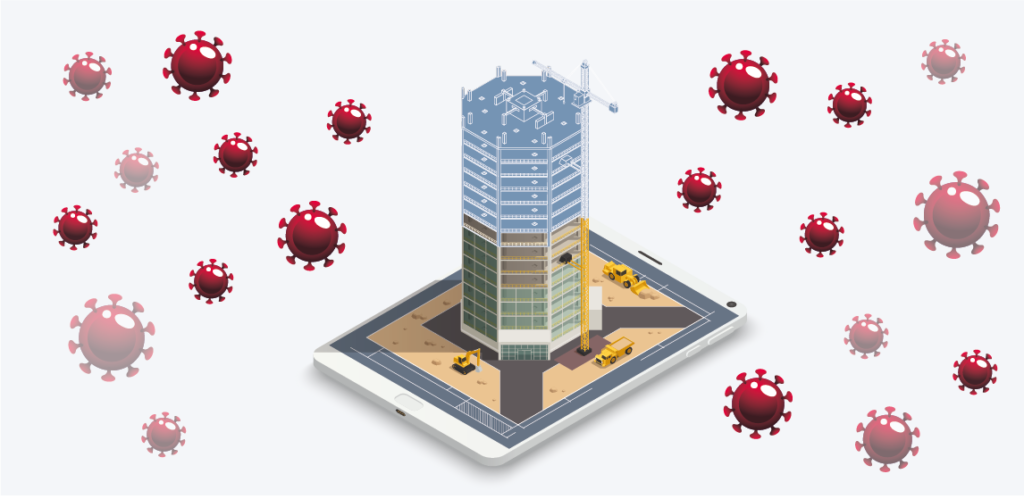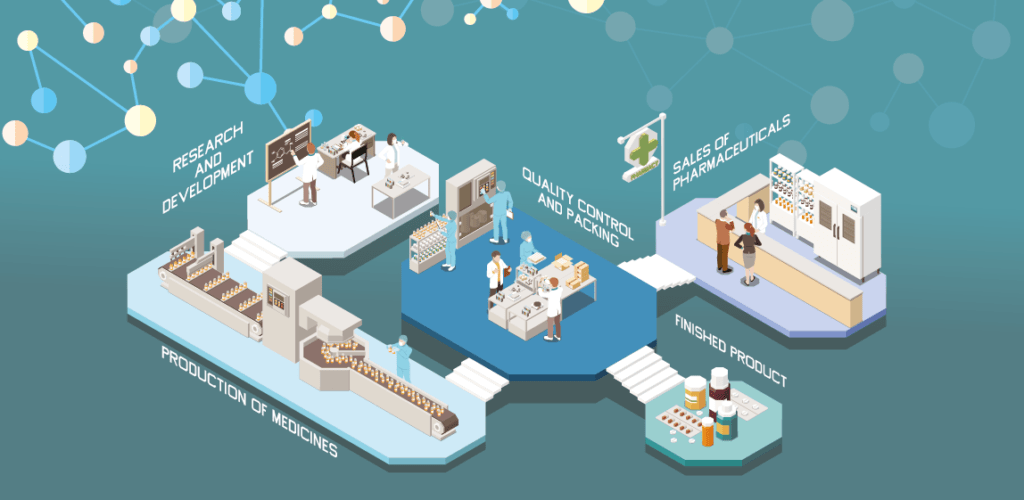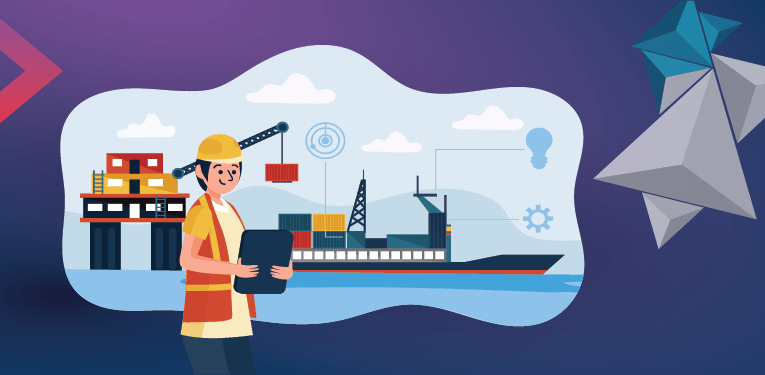The ongoing mega projects will transform Bangladesh economy – Part: 1
Japanese Economic Zone (Araihazar Economic Zone)
Japan along with China and India showed their interest to build government to government Special economic zones (SEZs) in Bangladesh. In March 2019, the Bangladesh government approved a project to establish a SEZ at Araihazar, Narayanganj which is only allocated for Japanese investors. Japanese Economic Zone (JEZ) in Bangladesh is going to create a conducive business environment and attract Japanese investors to invest in Bangladesh. It is expected that primarily Agro-food, Light engineering, Chemical, Automobile assembly, garments, and pharmaceutical, etc. industries will be set up.
Japanese Economic Zone (Araihazar Economic Zone)
Among the three G-2-G SEZs, the Japanese economic zone has seen maximum development. In January 2020, Toa Corporation started land filling work which was disrupted due to the pandemic situation, later on, in August 2020 they resumed their work. By the end of 2021, they are expected to hand over some plots to the investors.
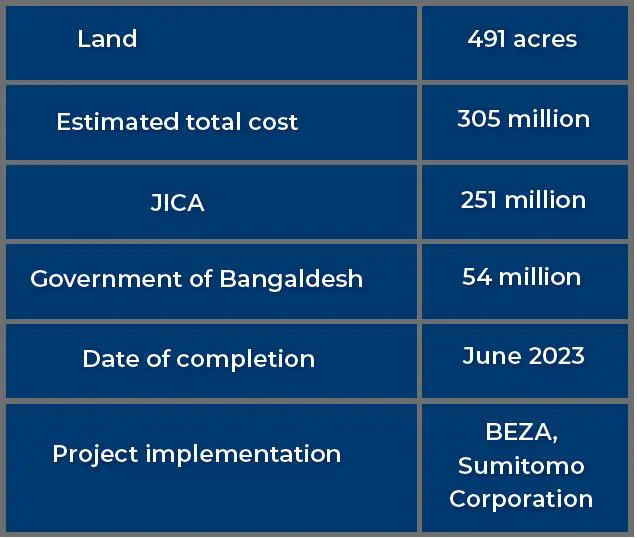
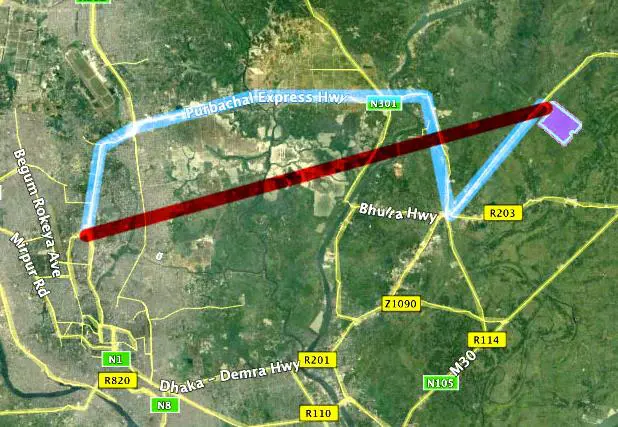
Japanese Economic Zone (Araihazar Economic Zone)
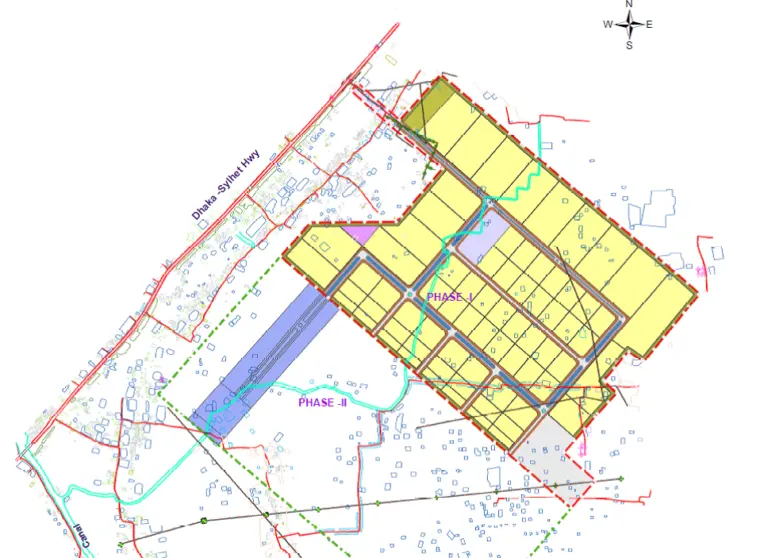
Japanese Economic Zone (Araihazar Economic Zone)
Socio-Economic Benefit of JEZ
The JEZ is not only going to create a conducive environment for investors but also going to create employment and earning opportunity for local inhabitants.
It is expected that at least 100,000 to 200,000 people will get job opportunity in that area. Bangladesh will get a chance to get around 2 billion dollars investment through 100-200 Japanese companies. Domestic industries will flourish with advance technology and a modern production facility.
Padma Multipurpose Bridge
The “Padma Multipurpose Bridge Project” will lead Bangladesh to reach the next economic landscape by enabling connectivity over the Padma river with a road-rail bridge – globally recognized as “Ganges”. It will be the largest bridge and first fixed river crossing traffic road in Bangladesh connecting Louhajong, Munshigang to Shariatpur and Madaripur which will link the south-western part to the northern and eastern region of Bangladesh.
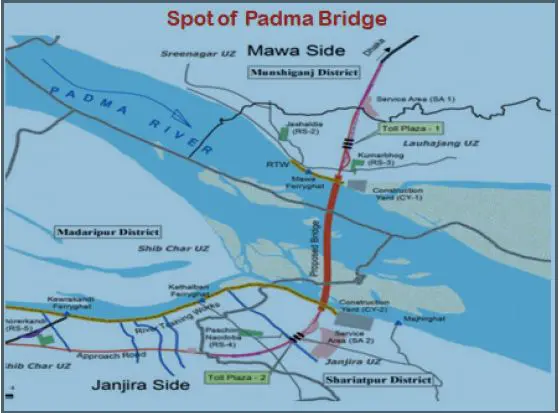
Red line indicates the main bridge over the Padma river
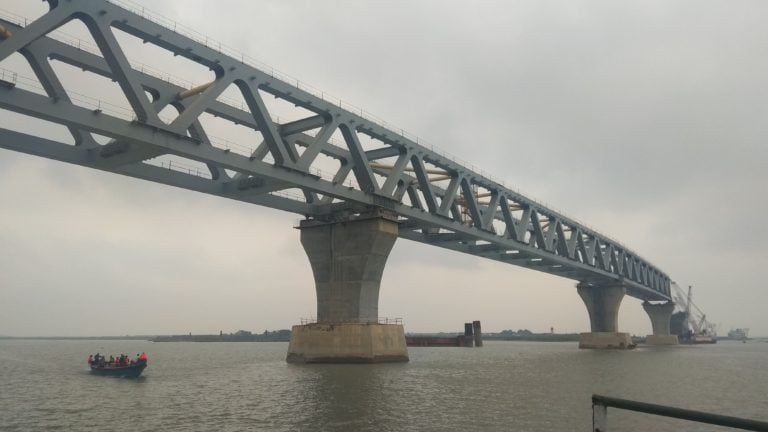
Full length of Padma bridge in now visible with the installation of 41th span
Padma Multipurpose Bridge
The Padma Bridge Project is at the eve of completion as the last (41th) span was installed on 10th December 2020 making the 6.15 kilometers double-deck bridge visible in full length. The COVID-19 pandemic had slowed down the progress in 2020 as one-third of the 1,200 foreign personnel involved with the project left Bangladesh amid a nation-wide lockdown declared in March 2020. However, the progression process has speed-up
since then. Overall, 90% of the construction work has been accomplished and the bridge is expected to be finished by late 2021 or early 2022.
Socio-economic importance of Padma Bridge
The Padma multipurpose bridge will help Bangladesh to reach the next level of economic landscape. It will enhance the commercial importance of the southwestern part of Bangladesh. The southern part of Bangladesh would become the one of the major economic hubs after the establishment of Padma Bridge. It is predicted that Bangladesh could have a remarkable increase in its GDP of 1.2%.
The importance of Mongla port would also increase dramatically for exports and imports while transportation cost will decrease significantly. It would increase the export of jute and frozen fish from the Khulna region – the main exports from the Khulna division.
Dhaka Elevated Metro Rail: MRT-6
Dhaka elevated Metro Rail project was undertaken by the Ministry of Road Transport and Bridges – supported by JICA – to reduce traffic congestion in Dhaka city. Also known as MRT-6, would be 20km long starting from Uttara to Motijheel consisting of 16 elevated sections. MRT-6 is getting constructed in an environment-friendly manner for having noise barriers and vibration-free tracks.
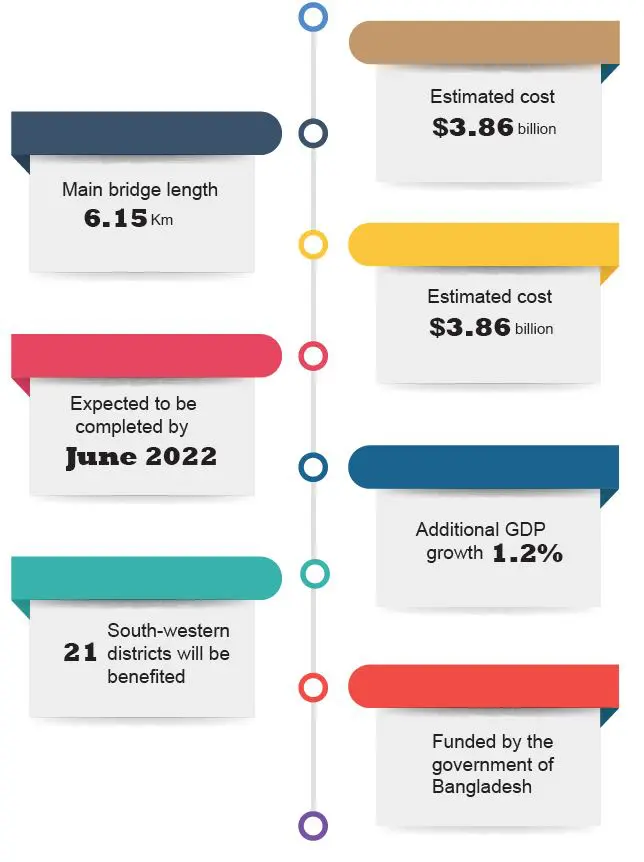
Overview of the Padma Bridge
Dhaka Elevated Metro Rail: MRT-6
The construction work of Dhaka metro rail was proceeding in a notable pace until the beginning of 2020. Unfortunately, the progress was hindered to some extent due to the COVID-19 pandemic. Due to the outbreak, the government of Bangladesh has shortened the budgets under the Ministry of Road Transport and Bridges which will be reflected on the Dhaka metro rail project. The budget allocation for the Dhaka Metro Rail Project for the fiscal year 2020-21 was Tk 4,370 crore – significantly lower than that of the previous fiscal year’s budget of Tk 7,212 crore.
Due to COVID-19 lockdown, labors, engineers and other officials were unavailable. Officials from many contractor companies of different countries left after March 2020. No progression of work was visible as
only a few workers were seen idle in different spots. However, Dhaka Metro Rail has got pace after June 2020 when everything was gradually returning to normal.
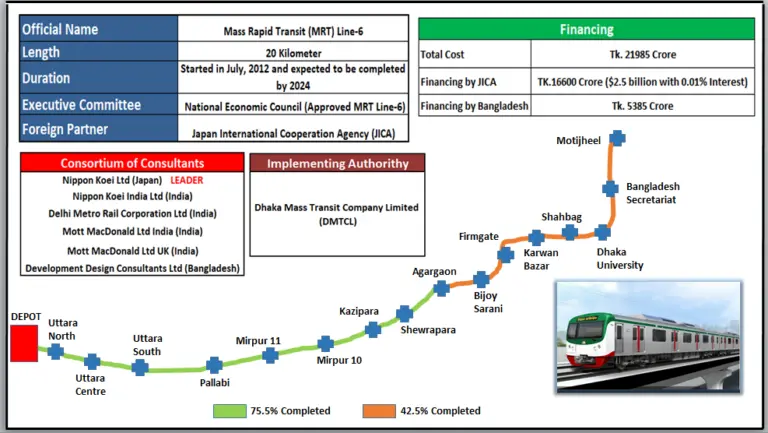
According to Mr. M.A.N Siddique, the Managing Director of Dhaka Mass Transit Company Limited (DMTCL), overall 49.15% of the elevated metro rail has been accomplished till September 2020. The first phase of the construction from Uttara to Agargaon is accomplished by 75.50% whereas the figure is 42.50% for the second phase from Agargaon to Motijheel. Around 10.83 km viaduct is visible out of 11.73km from Uttara to Agargaon. Mr. Siddique believes, if current progress sustains then rest of the remaining part of the project will be completed within December 2022.
Socio-Economic Benefit of MRT-6
Undeniably, Dhaka metro rail would bring pace in transportation in Dhaka. According to JICA, 14 trains would operate every three minutes and carry 60 thousand passengers per hour in both directions by reaching all 16 stoppages. It would take only 35 minutes to travel from Motijheel to Uttara which now takes 2 hours during business hours. For reducing traffic jam in Dhaka city, the metro rail project would act like a gem. According to a World Bank Report (2017), 3.8 million daily working hours are lost for the traffic jam in Dhaka. A staggering $4.35 billion is lost per year due to traffic congestion which is equal to 6.5% of the national budget. Therefore, Dhaka elevated metro rail is such a project which will bring betterment in the economic sector, transportation and the lifestyle of the city dwellers of Dhaka.
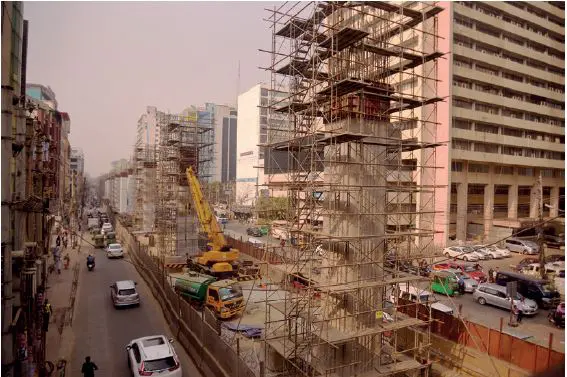
Construction works of MRT-6 in Dhaka city
Rooppur Nuclear Power Plant
The Rooppur Nuclear Power Plant is the first nuclear power plant in Bangladesh situated in Rooppur under Ishwardi upazila of Pabna district, on the bank of Padma River. This project is the largest initiative taken by the Bangladesh government with a capacity of 2,400 MW. Once completed, the Rooppur Nuclear Power Plant will help to accelerate the growth of the country’s industrial sector while contributing immensely to the overall economic development of the country.
Progress
On 30th November 2019, Prime Minister Sheikh Hasina inaugurated the concrete casting of Unit-1 of the power plant. So far 20% of the manufacturing project has been done, according to Bangladesh Atomic Energy Commission (BAEC). The complex for the reactor of Rooppur Nuclear Power Plant, Unit-1 is constructed more than 20 meters out of 40 meters. The first body part of hydro accumulator for passive core flooding system intended for Unit-2 of Rooppur Nuclear Power Plant (RNPP) is already being completed. The Covid-19 did not affect much over Rooppur nuclear power plant project. Rosatom, one of the contractors of Rooppur nuclear power plant project mentioned that 178 Russian
workers left Bangladesh for Covid-19 pandemic however the progress will not be affected because still, 4,000 people are working there. The construction of Unit-1 started in November 2017 and Unit -2 on July 2018. According to the World Nuclear Association, Unit-1 expected to be in commercial operation by 2023 or 2024 and Unit-2 by 2024 or 2025.
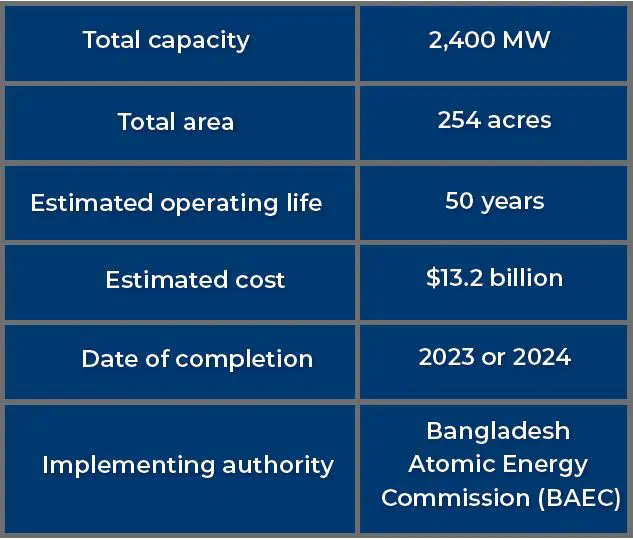
Importance of building Rooppur Nuclear Power Plant in Bangladesh
- For the instability of the fuel cost in the international market, the government needs to think about long-term cost efficiency for electricity production.
- Fuel consumption will reduce dramatically – the modern VVER-1200 reactor requires only 29 tons of Uranium fuel per year. During this period, coal plants of similar capacity consume 40 thousand railway cars of coal. Nuclear Power Plant can generate more than 2,000 kWh of electricity using only one gram of Uranium.
- Gas power plant can be an alternative but still, nuclear power plant is twice more efficient compared to other power plants. A gas-fired unit, similar capacity to the VVER-1200 reactor consumes 1,300 million cubic meters of natural gas per year whereas VVER-1200 needs only 29 tons of Uranium fuel.
- A feasibility study shows that the cost of electricity will reduce to less than Tk 5 per unit despite the huge investment of establishment.
- Radiation released in the environment by Nuclear Power Plant for 2000 years is equal to radiation released by an X-ray machine to diagnosis a patient for 2,000 years
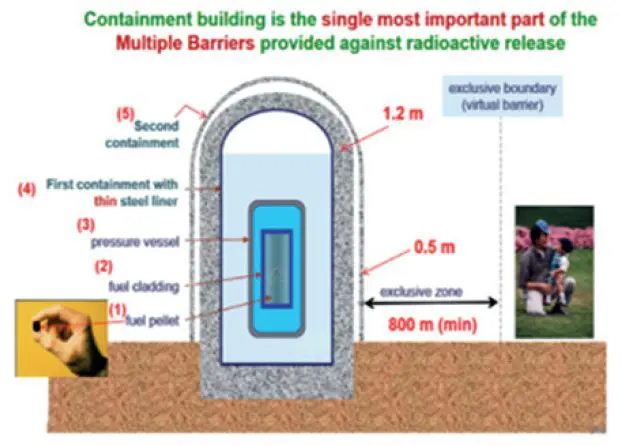
Payra Deep Sea Port
Payra Sea port, the 3rd sea port of Bangladesh is situated at Kalapara Upozela under Patuakhali district on the west bank of Rabnabad Channel. The main port would be 11 km in length and the whole project occupies 6,500 acres of land. It could play a significant role in the export-import industry of Bangladesh by reducing pressure over Chittagong and Mongla seaport. The port would be built on a G-to-G and Foreign Direct Investment (FDI) basis. The port was first established by an act of parliament on November 10th 2013 and officially inaugurated by Prime Minister Sheikh Hasina in 2016.
Current Status of Payra Sea Port
At present, the port is operating in a small scale. From 2013 to 2018, around 27 vehicles arrived at the port. Most of the transported goods were stone chips, cement clinkers, dredging materials, and plant machinery. MV Fortune Bird – a commercial vessel from China reached the outer anchorage of the port in 2016 – carried 53,300 tons of crushed black stones for the Padma Bridge Project.
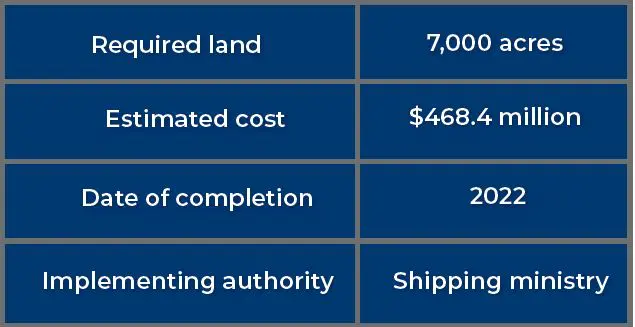
Difficulties in cost estimation – completion time is getting longer
In November 2015, the executive committee of National Economic Council (NEC) approved TK 1,128 crore for the building of primary infrastructure. However, the initial estimated cost has tripled (TK 3,982 crore) due to lack of feasibility study and wrong cost calculation. A new survey conducted by a consulting firm – after BUET – has found that the estimated cost has increased by Tk 847 crore for constructing the jetty and the proposed bridge.
Due to delay in cost calculation, loan agreements, land acquisition and bribery issues, the overall progress of construction is getting hampered. For instance, 1,200-metre multipurpose terminal costs Tk 5,219 crore is awaiting for approval. India will provide a loan of Tk 4,946 crore from Indian credit and the rest and Tk 273 crore will be provided by the government of Bangladesh. According to the feasibility study by a British firm HR Wallingford, the estimated cost for the Payra Sea Port project would be $20 billion. The project was planned to be completed by 2020. However, based on the obstacles, it might take more time to be accomplished.
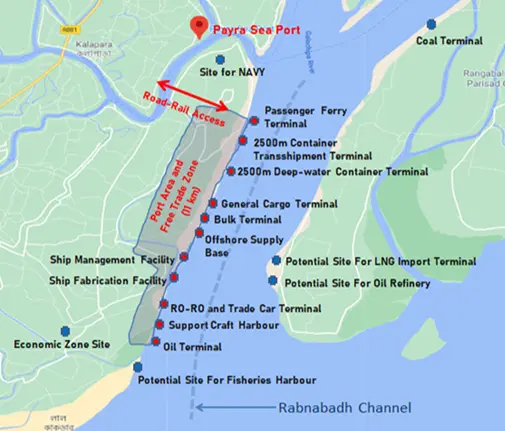
Socio-economic Developments
The government has intention to build an Exclusive Economic Zone (EEZ) in the southern part of Bangladesh based on Payra seaport. Different types of industries such as
garments, pharmaceutical companies, oil refinery, cement factories, fish processing zone, fertilizer factories etc. will be established there. Additionally, it would be helpful for Bangladesh to meet the demand of different sectors. For instance, Bangladesh can import more crude and finished oil to meet the growing energy demand. Besides, it could contribute hugely to strengthen the tourism sector centring to Kuakata beach and airport. Payra seaport will also play a significant role to accelerate the export-import of Bangladesh.
For lower navigability, currently, Chittagong Port Authority (CPA) cannot accommodate large vessels at Karnaphuli river. As a result, small vessels reach the large vessels in a distance to unload them. Unlike Mongla and Chittagong port, Payra seaport will not be tide-dependent and it will have higher navigability with greater depth. Therefore, large
vessels could be easily accommodated in the Payra seaport. Hence, unloading time will be faster and the cost of vessels movement will be reduced by one-third.
Chittagong-Cox’s Bazar Railway Project
Chittagong-Cox’s Bazar railway project includes 128 km single line dual-gauge passenger railway line [15]. Approximately, 102 km rail line will be constructed from Dohazari to Cox’s Bazar via Ramu. From Ramu the line would be extended to Gundhum which is near to Myanmar border. According to the report of Asian Development Bank (2019), nine new railway stations will be constructed at Dohazari, Satkania, Lohagara, Harbang, Chakaria, Dulahazra, Islamabad, Ramu and Cox’s Bazar. An oyster shaped modern rail station will also be built in Cox’s Bazar – home of the longest sea beach in the world. Besides, 4 large bridges, 39 medium bridges and 145 culverts will be built under this project.
Progress
The COVID-19 pandemic has slowed down the progress because the contractors could not move construction instruments to different locations. Besides, difficulties of the land acquisition process had also delayed the construction work. According to the Ministry of Railway, 38% of the railway link project has been completed until April 2020. However, the construction work accelerated gradually when the lockdown was eased after June 2020. In a statement, Mr Nurul Islam Sujan, the Railway Minister, said by September 2020, construction works of about 90% of the bridges and culverts c has been completed. So far 60% of the fieldwork is accomplished and the rest of the task is expected to be completed by March 2021. Overall 56% of the Chittagong – Cox’s Bazar railway link project has been accomplished and the total project is expected to be completed by June 2022.
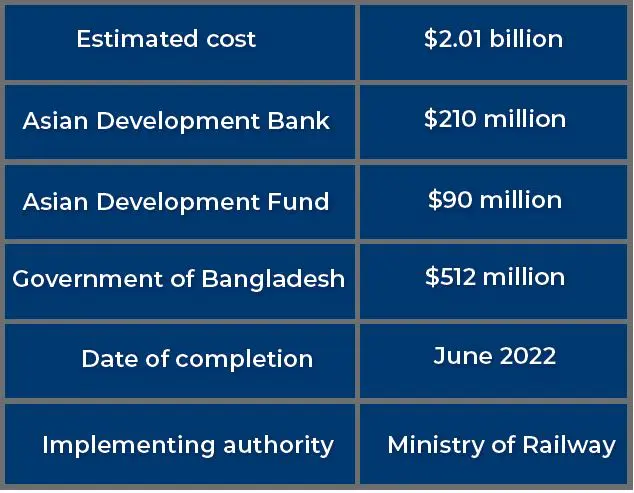
Socio-Economic Benefits
Bangladesh needs faster and safer connectivity among Dhaka, Chittagong and Cox’s Bazar for socio-economic development. This connectivity can be achieved through Chittagong- Cox’s rail project. Four hours o f travel time will be reduced from Chittagong to Cox’s Bazar. On the other hand, the ministry of railway has completed feasibility study for the Dhaka-Chittagong bullet train service. If this initiative is undertaken, it will take only 1 hour to travel from Dhaka to Chittagong. Therefore, only 5 hours will be needed to travel from
Dhaka to Cox’s Bazar – currently it takes around 12 hours. The Chittagong-Cox’s Bazar railway service would carry 2.9 million passengers annually from 2024. Prime Minister Sheikh Hasina is planning to introduce a high-speed tourist train on the Dhaka-Cox’s Bazar route based on the Chittagong-Cox’s Bazar rail project. Therefore, more tourists will be able to visit the tourist spots circling to Cox’s Bazar. In addition, this project will increase the connectivity of port city Chittagong with the capital Dhaka and other parts of Bangladesh. According to the plan of the Trans Asian Railway (TAR) Network, the project will be extended to the Matarbari seaport area and Myanmar border. Hence, the process of export-import will be accelerated in the ports.
